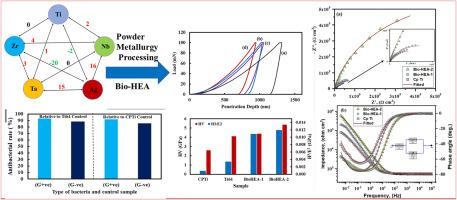开发用于牙科植入物的 Ti-Zr-Nb-Ta-Ag 高熵合金:体外腐蚀行为、抗菌效果和表面特性
IF 4.3
3区 材料科学
Q2 MATERIALS SCIENCE, MULTIDISCIPLINARY
引用次数: 0
摘要
本研究介绍了一种新型生物高熵合金(Bio-HEA),其成分为 35Ti-35Zr-20Nb-5Ta-5Ag(at.生物高熵合金经过不同时间的机械合金化处理,然后进行压实和烧结。对加工后的 Bio-HEA 在人工唾液介质中的耐腐蚀性、抗菌性能和表面特性进行了测试。使用原子力显微镜、表面轮廓仪和接触角测量法对表面形貌和润湿性进行了研究。通过机械合金化、X 射线衍射和扫描电子显微镜,发现形成了具有体心立方晶体结构的固溶体 Bio-HEA,其相变化取决于加工条件。Bio-HEA 的显微硬度值(4.38 GPa 和 5.35 GPa)明显高于商用纯钛(CPTi)和 Ti-6Al-4V 合金。与 CPTi 相比,增加球磨时间可提高 Bio-HEA 的显微硬度,并增强其在人工唾液中的体外耐腐蚀性。具体表现为腐蚀电位发生了约 200 mV 的明显偏移,腐蚀电流密度显著降低了约两个数量级,电荷转移电阻更高。此外,与 Ti-6Al-4V 合金和 CPTi 相比,Bio-HEA 的接触角更小。与 Ti-6Al-4V 合金和 CPTi 相比,Bio-HEA 的抗菌效率分别达到 91.76 % 和 93.0 %。与商用 Ti-6Al-4V 合金和 CPTi 相比,Bio-HEA 的微硬度、抗菌性能、在人工唾液中的体外耐腐蚀性和润湿性均有所提高,因此有望成为牙科生物种植体的候选材料。本文章由计算机程序翻译,如有差异,请以英文原文为准。

Development of Ti-Zr-Nb-Ta-Ag high entropy alloy for dental implants: In vitro corrosion behavior, antibacterial effect, and surface characteristics
This study presents a new biological high-entropy alloy (Bio-HEA) composed of 35Ti-35Zr-20Nb-5Ta-5Ag (at. %) for potential dental implant applications. The Bio-HEA underwent processing for various durations of mechanical alloying, followed by compaction and sintering. The processed Bio-HEA was tested for corrosion resistance in an artificial saliva medium, antibacterial properties, and surface characteristics. Surface topography and wettability were investigated using atomic force microscopy, surface profilometry, and contact angle measurements. Mechanical alloying, X-ray diffraction, and scanning electron microscopy revealed the formation of a solid-solution Bio-HEA with body-centered cubic crystal structures, with phase variations depending on the processing conditions. The Bio-HEA exhibited significantly higher microhardness values (4.38 GPa and 5.35 GPa) than commercial pure titanium (CPTi) and Ti-6Al-4V alloy, respectively. An increased ball-milling time resulted in higher microhardness for Bio-HEA and enhanced in vitro corrosion resistance in artificial saliva compared to CPTi. This was evidenced by a significant nobler shift of approximately 200 mV in the corrosion potential, with a prominent decrease of approximately two orders of magnitude in the corrosion current density and a higher charge transfer resistance. Additionally, the Bio-HEA demonstrated a lower contact angle compared to that of the Ti-6Al-4V alloy and CPTi. The Bio-HEA achieved antibacterial efficiencies of 91.76 % and 93.0 % compared to Ti-6Al-4V alloy and CPTi, respectively. The enhanced microhardness, antibacterial properties, in vitro corrosion resistance in artificial saliva, and wettability of Bio-HEA compared to commercial Ti-6Al-4V alloy and CPTi makes it a promising candidate for dental bioimplant applications.
求助全文
通过发布文献求助,成功后即可免费获取论文全文。
去求助
来源期刊

Materials Chemistry and Physics
工程技术-材料科学:综合
CiteScore
8.70
自引率
4.30%
发文量
1515
审稿时长
69 days
期刊介绍:
Materials Chemistry and Physics is devoted to short communications, full-length research papers and feature articles on interrelationships among structure, properties, processing and performance of materials. The Editors welcome manuscripts on thin films, surface and interface science, materials degradation and reliability, metallurgy, semiconductors and optoelectronic materials, fine ceramics, magnetics, superconductors, specialty polymers, nano-materials and composite materials.
 求助内容:
求助内容: 应助结果提醒方式:
应助结果提醒方式:


